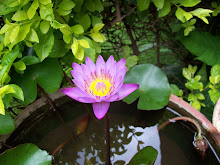 Yesterday morning, when I woke up, I could not see anything clearly with my right eye. Everything was in a haze, I could not even see the wall clock with my right eye, but I could see everything clearly with my left eye. When the situation did not improve even after washing my eyes repeatedly, I became panicky.I took an appointment with my Ophtholmologist and met her at 10.30 a.m.
Yesterday morning, when I woke up, I could not see anything clearly with my right eye. Everything was in a haze, I could not even see the wall clock with my right eye, but I could see everything clearly with my left eye. When the situation did not improve even after washing my eyes repeatedly, I became panicky.I took an appointment with my Ophtholmologist and met her at 10.30 a.m.
She did lots of tests and peered into my eyes with her instruments. Fortunately for me, her friend, a cornea specialist was also present there, who too peered into my eyes. He asked me whether I did a lot of gardening. I said yes, and he told me that there were multiple abrasions on my right cornea, caused by plant juices. He prescribed some steroid eye drops
which I have to continue using for 3 weeks. I have been thinking about the poisonous plants I handle daily, and here are some. The lantana in the topmost picture with its cheerful flowers, is a poisonous plant. All parts of the Nerium Oleander whose flowers I gather every day, are very poisonous. The Brugmansia plant is very poisonous, but its flowers are very beautiful.
I have been thinking about the poisonous plants I handle daily, and here are some. The lantana in the topmost picture with its cheerful flowers, is a poisonous plant. All parts of the Nerium Oleander whose flowers I gather every day, are very poisonous. The Brugmansia plant is very poisonous, but its flowers are very beautiful.
I
 The plant of the tomato, which I pulled out the day before , is also poisonous. I have a sneaking suspicion that the plant juices of the tomato have caused the injury to my eye.
The plant of the tomato, which I pulled out the day before , is also poisonous. I have a sneaking suspicion that the plant juices of the tomato have caused the injury to my eye.
 I have been thinking about the poisonous plants I handle daily, and here are some. The lantana in the topmost picture with its cheerful flowers, is a poisonous plant. All parts of the Nerium Oleander whose flowers I gather every day, are very poisonous. The Brugmansia plant is very poisonous, but its flowers are very beautiful.
I have been thinking about the poisonous plants I handle daily, and here are some. The lantana in the topmost picture with its cheerful flowers, is a poisonous plant. All parts of the Nerium Oleander whose flowers I gather every day, are very poisonous. The Brugmansia plant is very poisonous, but its flowers are very beautiful.I
 The plant of the tomato, which I pulled out the day before , is also poisonous. I have a sneaking suspicion that the plant juices of the tomato have caused the injury to my eye.
The plant of the tomato, which I pulled out the day before , is also poisonous. I have a sneaking suspicion that the plant juices of the tomato have caused the injury to my eye.There are many other mild and strong toxic plants in my garden, which I handle every day.I have learnt one important thing from this experience: If some plant juice gets into your eyes, you must immediately wash your eyes with water. That way, the risk of injuring your eyes are minimised.
My right eye has improved a bit, and today, I can see the wall clock, and also tell the time using my right eye.







